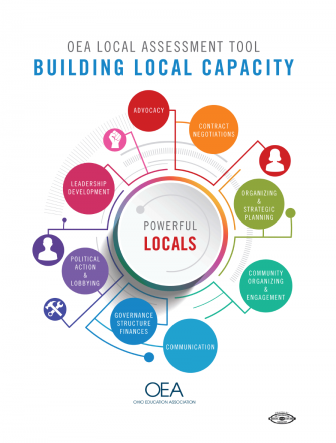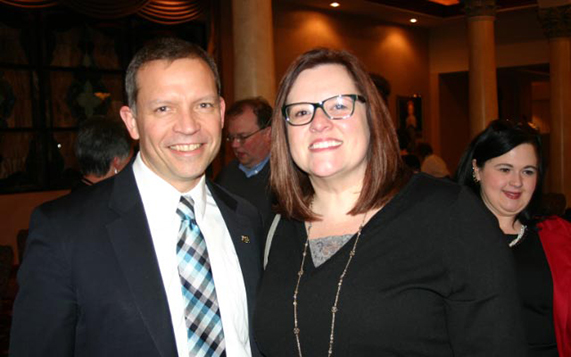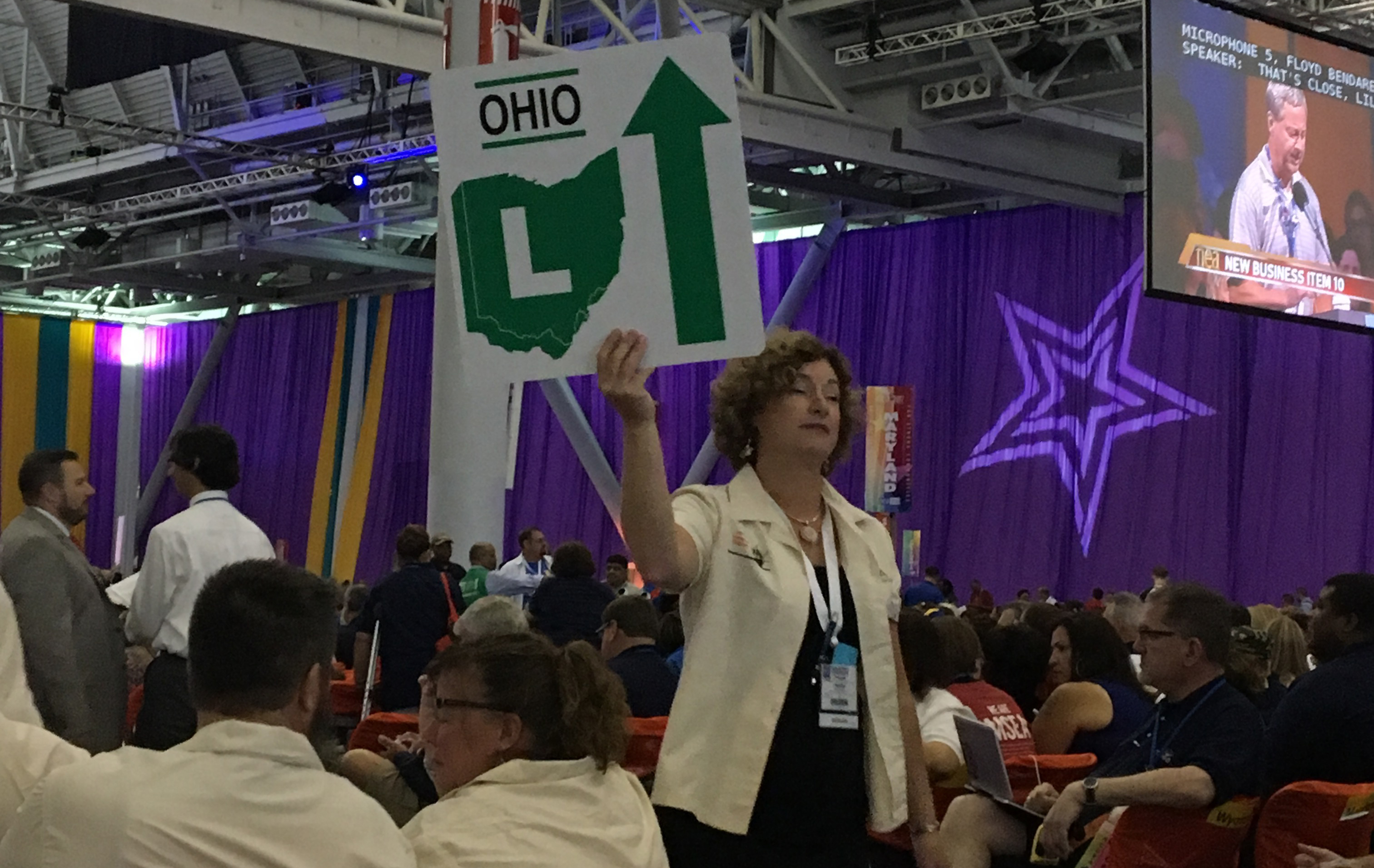OEA Locals Establishing Measurable Goals
 The OEA Organizing Department has developed a Local Self-Assessment Tool that can aide your local in targeting crucial areas of growth. Many locals have already begun to use this tool in order to assist them in strategic planning and goal setting. An active and strong local is always assessing their members’ needs and looking for ways in which to grow collective power. The OEA Local Assessment Tool looks at several key indicators that a well-rounded local should take into consideration for increased growth and strength. These are the following: Advocacy, contract negotiations, organizing and strategic planning, community organizing and engagement, communication, political action and lobbying, leadership development and governance structure/finances.
The OEA Organizing Department has developed a Local Self-Assessment Tool that can aide your local in targeting crucial areas of growth. Many locals have already begun to use this tool in order to assist them in strategic planning and goal setting. An active and strong local is always assessing their members’ needs and looking for ways in which to grow collective power. The OEA Local Assessment Tool looks at several key indicators that a well-rounded local should take into consideration for increased growth and strength. These are the following: Advocacy, contract negotiations, organizing and strategic planning, community organizing and engagement, communication, political action and lobbying, leadership development and governance structure/finances.
The tool is very useful for locals and provides them with an accurate reading on their overall organizational effectiveness and readiness. The process walks the self-assessment team through a number of steps to target areas of growth. Once this is achieved, the findings are discussed, and a consensus is reached, the real work begins.
Once the areas of growth are identified the local should develop a plan that sets up short term and long term (measurable or S.M.A.R.T.) goals. What should be achieved right now? What should we attempt to tackle in the long term? Resources and finances? Responsibility and accountability for the established outcomes? These are all questions to think about as locals plan for the future. You need to know where you are going before you figure out how to get there. One step at a time and strategic planning is the key.
This is also a great opportunity to engage and involve your members to participate and take ownership of the locals’ direction and vision. It provides them with a stronger voice and by doing so, they build a stronger local and union alongside their leaders.
I suggest that smaller locals take “smaller” steps so that the tool does not become cumbersome or overwhelming for them. The Organizing Dept. is now developing a shorter “field version” of the original tool. The Local Assessment Tool can be requested by sending us an e-mail or a hard copy can be obtained from your LRC.
Thank you for all you do and remember to keep ORGANIZING!
Ryan Dunn
OEA Director of Organizing & Member Engagement
dunnr@ohea.org
Perceptions and Procedures
Lessons from the 2017 NEA RA
Anyone who reads social media related to the OEA/NEA can see that the perception of some of our colleagues is that OEA/NEA isn’t doing enough about certain issues, or worse, isn’t listening to members’ opinions. If that is your perception, let me assure you as a first-time delegate to the NEA RA (Representative Assembly) held this summer in Boston, that our union leaders are listening.
The bulk of the time spent at the NEA RA consisted of presenting and debating New Business Items (NBIs), proposed amendments to current NEA Resolutions, new policies, etc. Anyone could submit an issue or amendment to be discussed on the floor. In our morning meetings with our fellow Ohio delegates, we listened to the recommendations of various OEA committees who had reviewed the upcoming issues and whose members gave us a brief explanation of why they recommended either supporting or opposing the item/amendment. There was frequently a debate, and then the Ohio Caucus voted on a position to take. However, it was made very clear that any delegate could vote however he/she chose. At the RA later that day, with delegates from all states present, and often after very robust debate, we voted. An Ohio communications team held up signs reminding us what our Ohio Caucus decided about the item, but we were not obligated to follow that decision. Sometimes other delegates proposed an amendment to the issue at hand, and the Ohio Communications team then showed signs with our Leadership Team’s recommendation regarding the change. Still, delegates could vote however they wished.
And they did.
If you ever want to see democracy in action, all you have to do is observe the floor of any OEA/NEA RA. If the verbal vote is too close to call, a standing vote occurs. In Boston, I saw friends, colleagues, and roommates next to each other…one standing, one sitting. We sat as a group but we voted as individuals, and it was powerful to see so many people united in respectfully making their opinions known.
The debates leading up to these votes were epic (if you don’t believe me, look up NEA RA memes on twitter!). Sometimes, a debate occurred over one word. For example, we debated whether or not the word “powerful” should be used in an NBI to describe the NEA, and whether or not the word “zealously” should be used to describe a particular action. More substantial issues were debated as well, such as when the NEA should endorse presidential candidates and the new NEA policy on charter schools. At this year’s RA, there were 159 NBIs, three Constitutional Amendments, 12 Standing Rule Amendments, eight Legislative Amendments, 16 Policy Statement Amendments, and 31 Resolution Amendments submitted. Each of these were discussed and debated.
It was my first time attending the NEA RA, which is basically like the OEA RA amped up. I had attended the OEA RA before, and so I thought I knew what to expect. That wasn’t always the case. Some issues that I felt would have short discussions actually spark some of the fiercest debates. In all of these cases, my eyes were opened to another perspective that I had not considered. And in all cases, the voices of the delegates were heard. Sometimes my vote fell on the victorious side and sometimes my vote was for the side that got defeated, but I have no doubt that the end results represented what the majority of the delegates wanted.
Being able to understand how someone else perceives an issue often complicates matters. Understanding someone else’s perception can make your own convictions less black and white. It can muddy your positions. But hearing the viewpoints of other OEA and NEA members is an opportunity for which we should be grateful. It is something we should value, and after attending both an OEA RA and the NEA RA as a delegate for the state of Ohio, I very much appreciate that our association goes to such lengths to hear every viewpoint before voting as a body. I have learned a lot about the process of how the NEA forms its core beliefs and the actions it takes in the name of those beliefs. Because I care very much about the perception of my colleagues in the OEA, I want to assure you that our various viewpoints are being heard at both the state and national levels.
It is no easy task to formulate policies and recommend actions that represent the members of the largest union in the country. The viewpoints of others must be taken into account and there must be a process for allowing that to happen. For me, being a part of the largest democratic deliberative assembly in the world was alternately exhausting and exhilarating, frustrating and gratifying, mind-numbingly boring and absolutely inspiring. It is also categorically vital to maintain our mission to offer the highest quality public education in the world to our students, and to do so while advocating for economic and social justice, diversity, tolerance, and fairness in our schools and in our communities.
I urge you to attend an OEA or NEA RA if you are given the opportunity. I am extraordinarily grateful for the chance to witness firsthand how our union discusses, debates, deliberates, and ultimately decides how to best serve our students and promote our shared values in these challenging times.
Learn more about the OEA Representative Assembly.
SCOTUS agrees to hear Janus case on fair share fees
COLUMBUS – September 28, 2017 – The following statement can be attributed to Ohio Education Association President, Becky Higgins:
“The decision today by the US Supreme Court to hear arguments in the case of Janus v. AFSCME is part of a long-standing effort by wealthy special interests to tilt the playing field even more in their favor by weakening unions that give working people a path to the middle class and provide economic stability to the communities in which we live. An adverse ruling could also hurt Ohio’s public schools by diminishing the ability of educators to advocate for learning conditions and curricula that best serve the needs of the students.”
The Ohio Education Association (ohea.org) represents 124,000 teachers, faculty members and support professionals in Ohio’s public schools, colleges and universities
Follow OEA @OhioEA on Facebook, Twitter, YouTube, Instagram, and Pinterest.
Save
Save
Save
Successful member organizing helps Maysville EA become first Ohio local to win back salary schedule
 In 2014, midway through the freeze, the administration presented MEA with a “white knight” solution known as alternative compensation developed with the guidance of Battelle for Kids, a non-profit organization intent on tying teacher employment and pay for performance based upon student test scores.
In 2014, midway through the freeze, the administration presented MEA with a “white knight” solution known as alternative compensation developed with the guidance of Battelle for Kids, a non-profit organization intent on tying teacher employment and pay for performance based upon student test scores.
Still reeling from stagnant wages and the defeat of SB5, members made the short-term decision to accept the alternative compensation proposal that came packaged with sweeteners and incentives, many of which were grant-based. Despite warnings from the local’s OEA labor relations consultant that the inequities of the system would be revealed once grant money disappeared, and that a return to their salary schedule might be impossible, 95% of voting members accepted the new compensation plan and, ultimately, its failures.
This year the exit of prior school district management and hiring of a superintendent who was not a strong advocate of tying teacher pay or evaluations to student test results, encouraged a group of MEA members to pursue a return to a traditional pay scale—used by 97% of Ohio school districts.
According to MEA President Myra Warne this was no small challenge for a local with 140 members in rural southeastern Ohio. “Nobody could remember the last time more than 25 or 30 people had come to a meeting,” Warne said. “And, as is often the case with small locals, previous negotiations had been informal and often occurred without the benefit of labor experts at the table.”
As newly elected MEA president, Warne, an English teacher at Maysville High School, promised member involvement and transparency in the process, recognizing that neither would be possible unless teachers were willing to unite behind the goal of achieving an equitable contract that would serve the best interests of all members.
“Nearly a quarter of our members were doing better with merit pay than they would have with the traditional system,” Warne said. “Some wouldn’t receive a raise if MEA returned to the old salary schedule because they had passed the top rung, but the other 75 percent of members had seen their pay stagnate for years. We had to convince those who were benefiting from the new system to support our efforts with the understanding that when management pits us against one another, it’s bad for the union as a whole.”
The MEA Executive Committee recognized that achieving its goal would require a plan to foster member engagement, beginning with a negotiations committee. An all-call for negotiating committee members produced 10 volunteers from different work areas and buildings who agreed to meet weekly, beginning in January 2017.
At the initial meeting, the team developed a plan with each committee member assigned an article of the existing collective bargaining agreement for review and recommendations. With the help of the local’s new LRC Jeremy Baiman, the group dissected the agreement, focusing on key areas. The team sought input from non-committee members in specific disciplines such as special education.
The group then took the unprecedented action of opening every article of the contract, something that had not been done in decades. They discovered a clause suggesting that the superintendent had the right to determine whether a teacher who had given birth was emotionally fit to return to work. In other areas, such as family medical leave, contract language was in violation of federal law.
Committee members were assigned review of specific articles. They also examined contracts from other locals and survey responses from MEA members, and made recommendations based on their research. After discussion, the group agreed on bargaining priorities.
Another critical step was analyzing the district’s spending and financials. On behalf of the MEA, the OEA filed a Freedom of Information Act request for all district salaries and compensation that revealed wide disparities in pay.
Warne said the committee found one teacher who would need to work 21 years under the alternative compensation plan to reach a salary of $51,500—the amount earned by the district’s executive secretaries. The member agreed to serve as a poster child for MEA’s efforts.
“It wasn’t enough to just say, ‘This is good for young teachers,’” Warne said. “We made sure we had permission to use member names, both at the bargaining table and with other members, so that we would have concrete examples.”
MEA’s research also revealed that the district was
top-heavy in administrative salaries—employing 17 administrators at a cost of $1.5 million to taxpayers, compared to 12 administrators in a similar-sized neighboring district. The union’s analysis of the district’s financials showed that the year it implemented merit pay, Maysville saved $700,000 in staff payroll. While the district was pleading poverty, its books showed $1.3 million in revenue over expenses.
Warne said, “exposing and highlighting these financial disparities engaged members, but we needed a strategy to sustain engagement and support throughout the bargaining process to ensure our success.”
Regular communication was key to providing the transparency promised to members early in the process. Committee members secured personal email address and cell phone numbers for each member and contacted teachers to collect accurate information regarding years of service and education levels.
Determining the cost for MEA’s proposal was crucial to securing a deal and math teacher Amber Williams spent hours creating formulae and manipulating data with respect to various counter proposals on compensation.
Communications team members Toni Stoepfel and Samantha Mitts kept members informed in real time, sending emails and text messages updating teachers on the progress of negotiations, and encouraging them to show solidarity by wearing member shirts, participating in group walk-ins, and wearing daily assigned colors to demonstrate unity.
Committee members were motivated and encouraged when, on the first day of negotiations, teachers showed up at school in MEA shirts and posted group pictures
to Facebook.
“As negotiations continued, we received motivational texts and emails from appreciative members, demonstrating the real reward—the fact that we were working hard on behalf of all members,” Warne said.
MEA kept members informed of the substance of negotiations and made sure they were involved in key decisions.
“After the first two days of bargaining, in which the district insisted on maintaining the merit pay system,
we told their negotiating team we needed member input before we could proceed,” Warne said. “On May 9, we held a meeting attended by two-thirds of our members—absolutely unheard of in our district—and presented members with three choices: continue to fight for the traditional step system; acquiesce to the alternative compensation scheme, but try to get a better deal; or work with the administration to come up with a combination of the two.”
Attendees voted soundly (91%) to continue MEA’s fight to regain the traditional pay scale, and the committee secured petition signatures from 87% of all members, signaling that they would do whatever it took to achieve the desired result.
A turning point for MEA was the attendance of 90 members at a school board meeting—so many members that the school board hired a deputy sheriff to attend the proceedings.
Bargaining concluded June 2 with a return to the traditional pay scale—making MEA the first local in Ohio to win back its salary schedule after giving it up.
Additional contract gains included a grandfather clause, ensuring that members who had exceeded their step-based salary would not take a pay cut, financial penalties for the district for exceeding class size targets, and additional release days for our special education teachers. The lone concession was an agreement to add 15 minutes to the workday, bringing Maysville into alignment with other local districts.
The contract was ratified with a 91 percent yes vote.
Preparation, communication and unity were the keys to MEA’s success.
“We began preparations early, sought member input and engagement in the process, created an expectation that our members would support these efforts, and refused to back down at the table,” Warne said. “Countless hours of preparation and research resulted in a successful negotiation for our local.
“We were willing to do the hard work required to negotiate a meaningful contract that serves all our members. It is this unity that brought us success. Our challenge is to maintain that solidarity and continue to develop relationships among members going forward.”
OEA Member Resource Guide 2017
Use this guide as an overview to help you make the most of your OEA Membership. Within, you’ll learn more about:
- Ways to Become Involved
- Fighting for Public Education
- OEA Staff, Leadership, and Board of Directors
- OEA Higher Education Benefit
- Awards and Scholarships
- Valuable NEA Member Benefits and Services
Throughout our more than 150-year history, OEA members have been involved in every struggle and effort to advance the finest of America’s dreams: a quality public education for every child.
If you have additional questions, contact us at 1-844-OEA-Info (1-844-632-4636) or send us an email to: membership@ohea.org.
Moved recently? Contact the OEA Member Hotline to update the address on file at 1-844-OEA-Info (1-844-632-4636) or email, membership@ohea.org. Representatives are available Monday-Friday, from 8:30 a.m. to 6 p.m. | OhioSchools — Past Issues
![]()
![]() Oh Yes, We’re Social — Join the Conversation!
Oh Yes, We’re Social — Join the Conversation!
![]()
Categories
Communications and Community EngagementLeadership Tools and Documents
Legal Issues
Legislative Issues and Political Action
Licensure and Certification
Membership
OEA Member
Ohio Schools Magazine
Professional Development
Representative Assembly
Salary and Benefits
Scholarships and Awards
Union Business
Ohio Education Association Re-Elects President And Vice President
COLUMBUS – May 16, 2016 – Members of the Ohio Education Association, the state’s largest public employee union, have re-elected Becky Higgins to a second three-year term as President, and Scott DiMauro to a second three-year term as Vice President. OEA represents 123,000 teachers, education support professionals and higher education faculty.
Higgins ran unopposed and was re-elected by acclamation at the OEA’s Representative Assembly (RA), the governing body of the organization, over the past weekend. Nearly 1,000 member delegates from OEA local affiliates throughout Ohio participated in the RA.Higgins will begin her new term on September 1, 2016. An active OEA member throughout her career, Higgins was a first-grade teacher for the Copley-Fairlawn Schools before being elected OEA’s president in 2013.
OEA Vice President Scott DiMauro also ran unopposed and was re-elected by acclamation. Prior to his election as vice-president, DiMauro was a social studies teacher at Worthington Kilbourne High School.
Follow OEA @OhioEA on Facebook, Twitter, YouTube, Instagram, and Pinterest.
###
The Ohio Education Association (ohea.org) represents 122,000 teachers, faculty members and support professionals in Ohio’s public schools, colleges and universities
The Power of Participation
By Julie Rine, Minerva Local Education Association
W hen I started teaching 20 years ago, some colleagues taught me some very important tricks of the trade: how to get on the janitor’s good side, how to sweet talk the secretary into making last minute copies for me, how to drink cheap beer (on a young teacher’s salary, that might have been the most important lesson!).
hen I started teaching 20 years ago, some colleagues taught me some very important tricks of the trade: how to get on the janitor’s good side, how to sweet talk the secretary into making last minute copies for me, how to drink cheap beer (on a young teacher’s salary, that might have been the most important lesson!).
And then one of those friends invited me (dragged me) to a negotiations committee meeting. I was a member of the association, but really had no interest in getting involved, primarily because I had absolutely no idea what the union did or how it did it.
I remember he said being on the negotiations committee was a good place to start, because one of the most important jobs of the union was to represent the teachers at the table, to work with the administration of the district to make gains that would better serve the students and teachers of the district.
Looking back, I know that he was trying to get younger teachers involved in the work of the local association, as I do now. It’s important that the ideals and goals of the union pass down from one generation to the next and that we keep getting stronger each time the leadership changes. That colleague is retired now, but I think he would be proud of my involvement with the union that all began with one meeting where we brainstormed the needs we wanted to present to the administration at our contract negotiations that year.
Since then, I have served as Vice President and an at-large representative for our local association (we really need a more flattering title for that position!) and I have represented our association on various committees. I have helped screen local political candidates, attended regional events such as the legal update dinner and the annual meeting with state legislators, and last year I participated in the Representative Assembly in Columbus.
“We might be individuals with different beliefs, experiences, and priorities, but together we form a unit to be reckoned with, one that proudly uses its power and strength to advocate for Ohio’s kids.” — Julie Rine
I’ll admit that the first time I went to the ECOEA Legal Update dinner, it was because it is held at a local restaurant known for good Amish cooking and fantastic pies. I still go back every year, but not just because of the pie; it is truly interesting to hear what court cases and legal issues are affecting teachers in Ohio (and frankly, sometimes quite horrifying!).
This was the first year that I attended the dinner with legislators, but it will not be the last.
To actually have conversations with the men and women who have the power to make decisions that affect education in Ohio is an opportunity that cannot be taken for granted. The State School Board members who joined us that night seemed just as frustrated as we are at the recent actions of several members of the Board.
The legislators answered our questions as best as they could, and it was evident that many of them truly have a heart for education and a desire to stop the madness that public education in Ohio has had to endure under Kasich’s leadership.
Not every question we submitted was presented to the panel that night due to time constraints, but every single submitted question was sent to the panel members afterward. Those men and women now know exactly what issues evoke our anger and our passion, and they will be able to better represent us  because of that three-hour event.
because of that three-hour event.
It was by default that I became our local association’s delegate to the Representative Assembly last year. Each spring, my local asks for people to indicate interest in serving on various committees or being our delegate to the RA. No one wanted to be the delegate. We have a very small budget for the delegates, and it’s actually possible to lose money by going to both fall and spring assemblies. I had no idea what to expect, but I and one other colleague agreed to go.
We held the election in the fall to make it official, but we were the only options. Because I was unable to attend the ECOEA RA prior to the one in Columbus, I did not get the delegate handbook until I arrived, but if I were to do this again, I would definitely get the handbook earlier; it explains what will be voted on, and gives many other details that would have kept me from going in blind.
At the assembly, I saw our union in action. There were the usual organizational tasks, budget reports, etc. (and I’ll confess this English teacher might have zoned out on the numbers, but I’m sure the math teacher delegates were paying attention!). What fascinated me most was the presenting of new business, new concerns and suggestions of issues on which the OEA should take an official position.
One of the issues that came up that year was whether or not there should only be one assembly per year, partly because of the financial strain two meetings can put on small districts like mine. On this issue and others, delegates from all over the state and from every local association could and did approach the microphones to make their opinions known, to make suggestions for language changes, and to offer compromises when the supporters of two opposing viewpoints seemed to be at complete odds with each other. The debates were respectful and orderly; a vote was held and the voices of our members were heard.
One way of getting involved in the union that I have not yet experienced is an annual OEA Lobby Day, and I look forward to participating in that at some point. First, though, I better practice a lot more yoga and deep breathing, because I have a feeling it would be a challenge to keep my temper in check if I ever met some of our current legislators.
If you are not involved in your local or district association, I urge you to consider being more active next year. Join a committee, or attend a yearly regional meeting of some sort (if you’re lucky, one with good pie!).
It might seem like just another meeting after school or just another annual event, but every time an association member is active in any way, our power grows. We might be individuals with different beliefs, experiences, and priorities, but together we form a unit to be reckoned with, one that proudly uses its power and strength to advocate for Ohio’s kids.
Categories
About Voices of ChangeCollective Bargaining
Education Support Professional
General
Higher Education Faculty
Higher Education Staff
Legislative Issues and Political Action
Local Leader
Member Stories
Membership
New Teacher
Non-educator
OEA Member
Organizing
preK-12 Teacher
Retired Member
Student Member
Union Business
February 2013 Ohio Schools
- IN THIS ISSUE
- OEA joins statewide coalition to promote importance of ties between communities and public schools
- OEA Crisis Response Team aids Newtown students and staff in wake of tragedy
- Grab your hat and read with the cat
- Legislative update, Association news, and more
Moved recently? Contact the OEA Member Hotline to update the address on file at 1-844-OEA-Info (1-844-632-4636) or email, membership@ohea.org. Representatives are available Monday-Friday, from 8:30 a.m. to 6 p.m. | OhioSchools — Past Issues
![]()
![]() Oh Yes, We’re Social — Join the Conversation!
Oh Yes, We’re Social — Join the Conversation!
![]()
October 2011 Ohio Schools
- IN THIS ISSUE
- Make a difference – vote NO on Issue 2 – Educators are coming together to speak out against Issues 2. Issue 2 gets in the way of doing their jobs, means larger class sizes, and makes it harder to focus on giving kids the individual attention their need to succeed.
- Rebuilding Union strength – Attend the 2012 OEA Collective Bargaining Conference
- Legislative update, Association news, and more
Moved recently? Contact the OEA Member Hotline to update the address on file at 1-844-OEA-Info (1-844-632-4636) or email, membership@ohea.org. Representatives are available Monday-Friday, from 8:30 a.m. to 6 p.m. | OhioSchools — Past Issues
![]()
![]() Oh Yes, We’re Social — Join the Conversation!
Oh Yes, We’re Social — Join the Conversation!
![]()
August 2011 Ohio Schools
- IN THIS ISSUE
- Our rights, our fight – As OEA and fellow union members throughout the state and nation face unprecedented attacks on their rights and jobs, being an active member and advocate is more important than ever before
- Record breaking petition drive ensures Senate Bill 5 Referendum on November ballot
- Legislative update, Association news, and more
Moved recently? Contact the OEA Member Hotline to update the address on file at 1-844-OEA-Info (1-844-632-4636) or email, membership@ohea.org. Representatives are available Monday-Friday, from 8:30 a.m. to 6 p.m. | OhioSchools — Past Issues
![]()
![]() Oh Yes, We’re Social — Join the Conversation!
Oh Yes, We’re Social — Join the Conversation!
![]()





